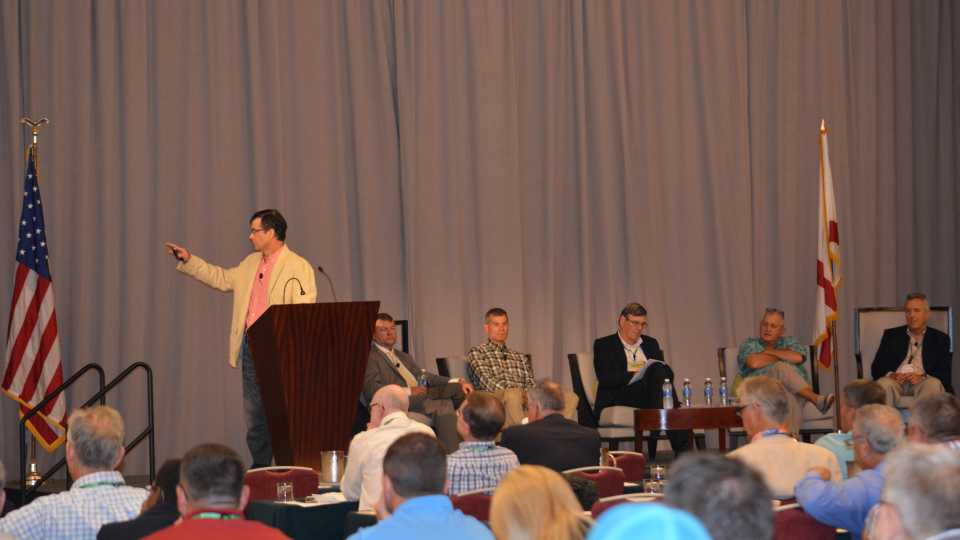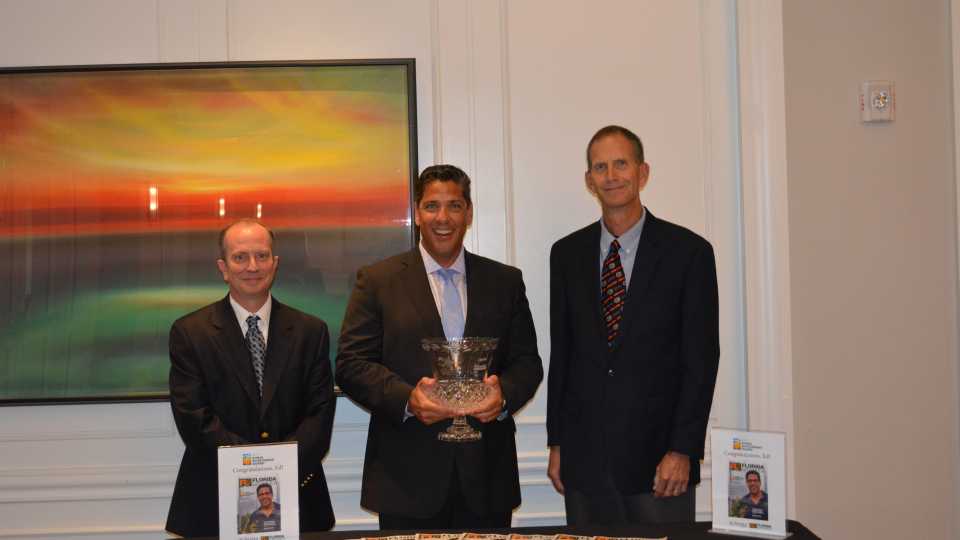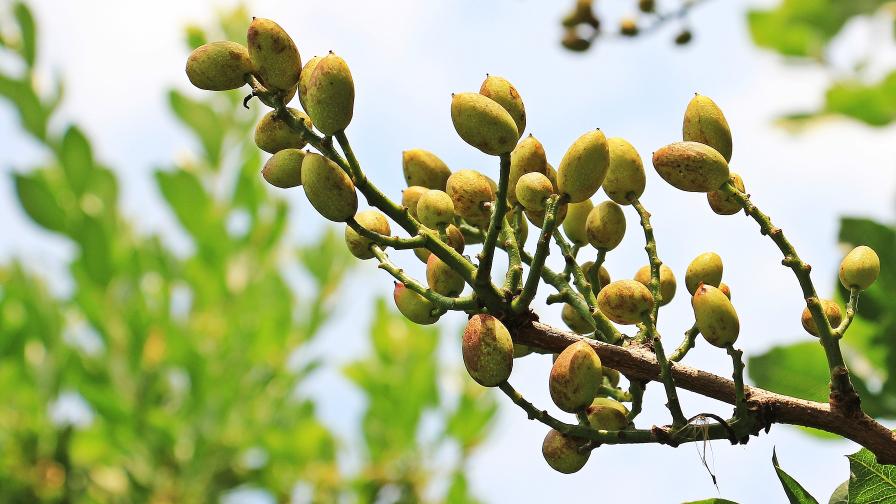Florida Citrus Industry Annual Conference Takes Aim at HLB

The grower panel during the 2017 Florida Citrus Industry Annual Conference drew a great deal of interest among attendees. Photo by Frank Giles
The 2017 Florida Citrus Industry Annual Conference hosted by Florida Citrus Mutual drew a great crowd, eager to learn about the latest breakthroughs in the fight against HLB. Educations sessions and conversations focused on what more immediate actions could be taken against the disease and/or its vector, the Asian citrus psyllid (ACP).
Tom Jerkins, President and General Manager of Premier Citrus, is currently serving as President of the Citrus Research and Development Foundation (CRDF). He opened the conference’s education sessions with an overview of where current research stands.
One point Jerkins emphasized was a strategic goal set forth by the CRDF in June 2009, which stated: “Save this generation of trees, employees, and growers.” He also noted that, to date, the Foundation has solicited, awarded, and managed nearly 400 contract grants in research, product development, and service support totaling more than $125 million.
The CRDF’s short-term initiatives (three-year time frame) focuses on HLB-bacteria (CLas) intervention, ACP intervention, and host intervention. When it comes to CLas intervention, Jerkins said there will be an emphasis on optimizing the use of currently approved bactericides and finding new materials that can kill the bacteria. Jerkins said those materials do exist, but it is a matter of how to get those materials into the tree to make contact with the bacteria. It may come down improved adjuvants of finding materials small enough to enter the phloem.
Jerkins pointed out the April 2017 issue Florida Grower® magazine, which featured the work Dr. Swadesh Santra from UCF to develop a nanotechnology-based zinc material. The material has proven effective against canker, and shows promise as a treatment for HLB.
He also stressed, but for one little germ [CLas], Florida’s citrus is on the cusp of a renaissance. Addressing the general angst that with more than $200 million spent, there is not more progress defeating that little germ, Jerkins said. “I’d like to think we are not $200 million poor, but $200 million smarter and closer to a solution.”
The infrastructure, acres, capital, and expertise to grow citrus sits ready to go into action when the solution is found. And Jerkins reminded everyone that Florida is the undisputed best geographic zone on the globe to grow citrus.
Bactericide Performance
Without question, the hottest topic during the conference was the current performance of bactericides as a treatment for HLB. Both registrants of currently approved products, NuFarm and AgroSource, presented their findings in bactericide trials. While their data showed generally positive results from company field trials, growers’ experiences have been far more mixed.
Jerkins returned to speak on observations made by Premier Citrus in its first year of bactericide use. Valencia groves had meaningful controls, particularly from five large tracts. He said it was not easy to see any supporting evidence of efficacy, at least by year-over-year yield data. He said most, but not all, of his production managers think they see some tree health improvement, but all concede there is no measurable evidence. In fact, in the aggregate, yield loss as a percentage was higher in the bactericide treated areas versus untreated; -10% vs. -6% respectively.
But Jerkins said there were complicating factors like postbloom fruit drop that could have skewed results. For oranges, while they would have like to have seen more evidence of performance, he said Premier Citrus plans to apply bactericides again in the coming season, hoping for a year-over-year compounding benefit.
“As to grapefruit, lets just say it [bactericides as HLB therapy] is — disappointing,” he said. “It may be measurable that some HLB benefit against controls exist, but nothing in two years of usage suggests that the antibiotics are slowing down the rapid decline of grapefruit. Premier will continue to use the streptomycin product for canker control, but will likely drop the oxytetracycline in grapefruit.”
Grower Talks
Another highlight of the conference education program was a grower panel discussing production tactics in the midst of HLB. The growers on the panel were positive and believe it is possible to grow citrus in an HLB-endemic environment as long as prices support the management required to do so.
Glenn Beck, a grower and caretaker for other growers, said his program has gone back to the basics. After trying a multitude of programs and trying to tease out what made the difference, he said the only common thread was time. Trees get infected, rapidly decline, and then slowly come back after bottoming out. He presented a number of photos of groves that had all but been given up on that now look great.
“We are excited about the tree health we have seen the last couple of seasons,” Beck said. “We had a lot of growers telling us they could no longer afford the higher inputs.”
Based off that, Beck has dialed back his program on his farm and for clients. And, given time, the trees appear to be responding.
“Basically, our program right now is what it would have been pre-HLB,” he said. “That allows us to operate in a reasonable amount of costs and we are getting results.”
Grower Larry Black told attendees the Peace River Citrus Company (where he works) is putting an emphasis on higher density in new plantings to speed up the production curve. In recent plantings, configurations followed 8’x18’ at 303 trees per acre. Test blocks have been put in place to evaluate 8’x15’ at 363 trees per acre and 4’x8’ (x 18’) at 495 trees per acre.
David Howard of Graves Brothers and Marty McKenna of McKenna Bros. also presented how their respective farms were modifying plant nutrition programs and other available tools to stay in the game despite the ravages of HLB. The panel underlined the basic theme of the day: Work with the tools you have, plant trees, and hang on for better solutions.
Or as Beck put it, “I have never seen anybody triumph over anything by doing nothing.”

Frank Giles (left), Editor of Florida Grower magazine and Richard Royal (right), Arysta LifeScience, presented Ed Pines with the 2017 Citrus Achievement Award trophy during the conference.
Ed Pines Takes Home the Trophy
Florida Grower magazine and Arysta LifeScience honored Ed Pines with the 2017 Citrus Achievement AwardSM during the Florida Citrus Industry Annual Conference banquet.
Pines was selected as this year’s winner for his pioneering work in planting citrus under protective screen (CUPS) to exclude psyllids and HLB. His 20-acre CUPS planting near Lake Wales is among the first commercial ventures in Florida.










